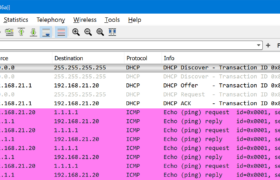This is part three of the DHCP relay mini-series: In this setup we still have two DHCP servers in load balancing configuration, but we also have two routers in the DHCP client subnet acting as DHCP relays. The routers are running HSRP (Hot Standby Routing Protocol) for first-hop routing redundancy, but it’s really not relevant […]
DHCP Relay, Part 2: One Relay, Two Servers
This is part two of the DHCP relay mini-series: In this setup there are two DHCP servers in load balancing configuration, so the DHCP relay has been configured with two DHCP server IP addresses where to forward the DHCP packets to: 10.0.41.10 and 10.0.41.11. The methodology from the first post is followed: the DHCP client […]
DHCP Relay, Part 1: One Relay, One Server
Tools for Debian Packages
Debian has been my primary Linux distribution of choice since 2003. That’s twenty years! How time flies! I haven’t ever worked as full-time server administrator but running and operating various kinds of systems have always been part of my skills, and it has made it possible for me to leverage wide range of tooling required […]
Capturing Packets on Windows with Packet Monitor (Pktmon)
As https://learn.microsoft.com/en-us/windows-server/networking/technologies/pktmon/pktmon puts it: Packet Monitor (Pktmon) is an in-box, cross-component network diagnostics tool for Windows. It can be used for packet capture, packet drop detection, packet filtering and counting. Nice thing about it is that it is present by default on all modern Windows versions, so you can do a quick packet capture when […]
Parametrizing Test Functions with Pytest
I will first create a class that is used for representing the Zabbix protocol flags (zabbix_flags.py): Subclassing enum.IntFlag is very suitable for this purpose, and enum.auto() can be used to represent the flag values. I have four test functions to check that the flag values work as expected (test_zabbix_flags.py): Let’s create a virtual environment and […]
Python Versions
(Note: This page is updated every now and then, according to new Python releases and other interesting details. Last updated: 2025-11-09) Even though I’ve used Python programming language on-and-off since about year 2000, I only started paying more attention to specific Python versions around 2016 when I gradually started using Python more seriously in devops. […]
Using Tmux
A long time ago I discovered screen. It made it possible to start applications in Linux and then disconnecting the SSH session, without stopping the applications. It was magic: otherwise the the applications just terminated if the SSH connection was lost. Then I heard about tmux. It was like screen on steroids! I could split […]
Serial Console Server on Raspberry Pi
Short one: How to make a serial console server (or terminal server) with a Raspberry Pi and USB-serial adapter. Update in December 2024: It seems the newer ser2net versions use /etc/ser2net.yaml as the configuration file. This is an example of an accepter line: Connect the serial port to whatever device you want to use for […]
Data Buffering in Zabbix Proxy
One of the features of Zabbix proxy is that it can buffer the collected monitoring data if connectivity to Zabbix server is lost. In this post I will show it happening, using packet capture, or packet analysis. Zabbix setup and capturing Zabbix proxy traffic This is the setup in this demo: For simplicity, the agent […]




